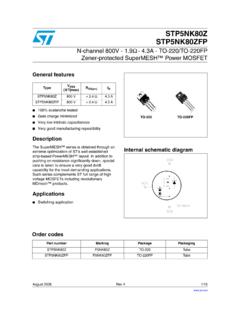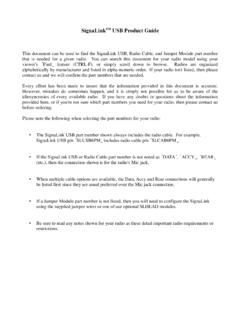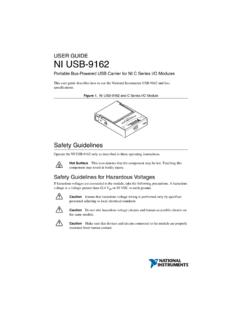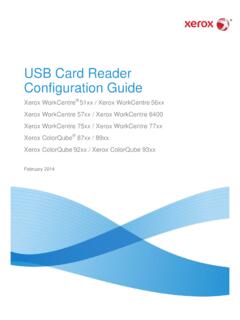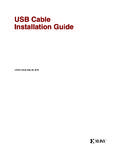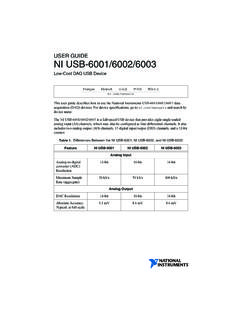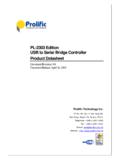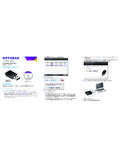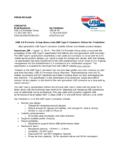Transcription of USB Power Delivery and Type-C - st.com
1 USB Power Delivery and Type-COverview Architecture product PortfolioSolution USB Type-C OverviewUSB Power Delivery specification introduces USB Type-C receptacle, plug and cable; they provide a smaller, thinner and more robust alternative to existing USB interconnect. Main features are: Enable new and exciting host and device form-factors where size, industrial design and style are important parameters Work seamlessly with existing USB host and device silicon solutions Enhance ease of use for connecting USB devices with a focus on minimizing user confusion for plug and cable orientation USB Type-C Overview Enable newand exciting host and device form-factorswhere size.
2 Industrial design and style are important parameters Work seamlesslywith existing USB host and device silicon solutions Enhance ease of use for connecting USB devices with a focus on minimizing user confusion for plug and cable orientation Simple Power Delivery implementation (BMC) Type-C FeaturesMode of OperationNominal VoltageMaximum CurrentNotesUSB V500 mADefault current, based on definitions in the base specificationsUSB V900 mAUSB BC VUp to ALegacy chargingUSB Type-C @ A5 ASupports highpower devicesUSB Type-C @ A5 V3 ASupports higher Power devicesUSB PDConfigurable up to 20 VConfigurable up to 5 ADirectional control and Power level managementThe Re-Evolution of USBUSB has evolved from a data interface capable of supplying limited Power to a primary provider of powerwith a data interfacePower DeliveryMore Powerwith USB Power Delivery (100W)
3 Type-CMore Flexibilitywith a new reversible USB-C connectorAlternate ModeMore Protocols(Display Port, HDMI, VGA, ) USB IFMore Speed with USB (10 Gbit/s)USB PD Power Profilesas of today .. per USB PD release PD New Profiles proposalType-C Pin Outs FunctionsReceptacleA1A2A3A4A5A6A7A8A9A10 A12A12 GNDTX1+TX1-VBUSCC1D+D-SBU1 VBUSRX2-RX2+GNDGNDRX1+RX1-VBUSSBU2D-D+CC 2 VBUSTX2-TX2+GNDB12B11B10B9B8B7B6B5B4B3B2 B1 USB GroundCable Bus PowerSecondary BusConfiguration ChannelTwo pins on the USB Type-C receptacle, CC1 and CC2, are used in the discovery, configuration and management of connections across USB Type-C cableHigh Speed Data Path (RX for USB , or reconfigured in Alternate Mode)
4 High Speed Data Path (TX for USB , or reconfigured in Alternate Mode) Type-C Pin Outs FunctionsPlugA12A11A10A9A8A7A6A5A4A3A2A1 GNDRX2+RX2-VBUSSBU1D-D+CCVBUSTX1-TX1+GND GNDTX2+TX2-VBUSVCONNSBU2 VBUSRX1-RX1+GNDB1B2B3B4B5B6B7B8B9B10B11B 12 USB GroundCable Bus PowerSecondary BusConfiguration ChannelHigh Speed Data Path (RX for USB , or reconfigured in Alternate Mode)High Speed Data Path (TX for USB , or reconfigured in Alternate Mode) On a standard USB Type-C cable, only a single CC wire within each plug is connected through the cable to establish signal orientationThe other CC pin is repurposed as VCONNfor powering electronicsAlso, only one set of USB D+/D-wires are implementedArchitectureCommunication across the channel uses BiphaseMark Coding (BMC) over CC in Type C connectorArchitecture and key wordsProviderPowerSource(s)SourceportUSB PortVBUSType A/B PlugidentificationCC ( Type-C only)
5 Device Policy ManagerPolicy EngineProtocol LayerPhysicalLayerCableDetectionBFSKBMCC onsumerPowerSinkSinkportUSB PortVBUSType A/B PlugidentificationCC ( Type-C only)Device Policy ManagerPolicy EngineProtocol LayerPhysicalLayerCableDetectionBFSKBMCV BUSCCUSB Type-C CC ConnectionsConnection Detection and muxes controlConnection DetectionDFP -Source UFP - Sink4 possible CC configurations Detect attach/detach of USB ports, a DFP to a UFP Resolve cable orientation and twist connectionsto establish USB data bus routing Establish DFP and UFP roles between two attached ports Discover and configure VBUS USB Power Delivery CommunicationUSB PD Stack & PolicySystem Policy Manager (system wide) is optional.
6 It monitors and controls System Policy between various Providers and Consumers connected via USB. Device Policy Manager (one per Provider or Consumer) provides mechanisms to monitor and control the USB-PD within a particular Provider or Consumer. It enables local policies to be enforced across the system by communication with the System Policy Manager. Policy Engine(one per Source or Sink Port) interacts directly with the Device Policy Manager in order to determine the present local policy to be Protocol Layerforms the messages used to communicate information between a pair of ports.
7 It receives inputs from the Policy Engine indicating which messages to send and indicates the responses back to the Policy EnginePoliciesProtocol LayerIt is responsible for sending and receiving messages across either the VBUSor CC wire. It consists of a transceiver that superimposes a signal (BFSK on VBUSor BMC on CC) on the wire. It is responsible for managing data on the wire and for collision avoidance and detects errors in the messages using a CRCP hysical LayerDevice Policy ManagerPolicy EngineProtocol LayerPhysicalLayerUSB interface (optional)USB PD deviceVBUS / CCUSB hub tree (optional)System Policy ManagerUSB HostProduct PortfolioSuperSpeedSwitchHost, USB ControllerAccess Point (optional)
8 Type-C connectorPower ManagementUSB Power Delivery ControllerProtectionsA complete offer to lean in USB PD EcosystemPHY - Type-C interfaceProfile 1-2- 3 Power Source Building Blocks maintransformerpulsetransformeroptocoupl ercommunicationFlybackController:STCH02 RectifierCC/CVSEA01 High VoltageLow VoltagePower MOSFETF eedbackNetworkSelectionDC/DCPost regulationUSB PDInterface IC USB PDInterface IC It covers profile 1-2-3 from 5W to 45W High Efficiency Low EMI design: intelligent Jitter for EMI suppressionMulti Port case: Post regulation for each portSTCH02 Primary Side Controller: Adapters up to 45 WSO8 Proprietary Constant current output regulation (CC) with no opto-coupler 700V embedded HV start-up circuit Quasi-resonant (QR) Zero Voltage Switching (ZVS) operation Valley skipping at medium-light load and advanced burst mode operation at no-load for under 10mW consumption Accurate adjustable output OVPF eaturesBenefits Low part count.
9 BOM reduction thanks to an extensive features integration Exceeding 5 stars: No-Load Power < 10mW HV start-up zero Power consumption Advanced burst-mode operation Flexibility: suitable for adapters from 5W to 40W High Efficiency Low EMI design: intelligent jitter for EMI suppressionProfile 4, 5 Power Source Building Blocks maintransformeroptocouplerPFCL6563 HSynchrounous Rectification SRK2001CC/CVSEA01 High VoltageLow VoltageDC/DCPost regulationUSB PDInterface ICLLCL6699 Power MOSFETP ower MOSFET PFC-LLC Integrated New solution STCMB1 Post Regulation1 per portSO16L6563 HTransition Mode PFC controllerDatasheet.
10 Available on 700V High Voltage Start-up circuit Fast bidirectional input voltage feedforward Adjustable OVP AC Brownout Detection Tracking boost function Inductor saturation protection Proprietary THD optimizer circuit Interface for cascaded converters -600mA/+800mA gate driverFeatures Low steady state ripple and current distortion with limited undershoot or overshoot of the pre-regulator s output thanks to new input voltage feed-forward implementation Reduced THD of the current High reliability thanks to a full set of protections HV start-up significantly reduces consumption compared to standard discrete circuit solutions Facilitated cooperation with cascaded DC-DC converter thanks to several Power management & housekeeping functionsSO16NL6699 High Power adapters 90W to 250 WDatasheet.









